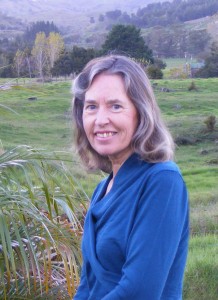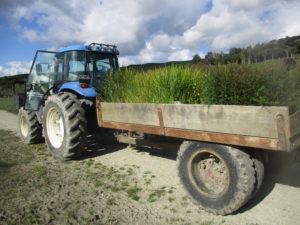
Coolest trailer carrying seedlings poised for planting.
As the farmer set off to work with four professional tree planters, I thought about the behind-the-scenes effort that’s often required to produce results.
Years of grit, guts, luck, courage, team work and a heap of money was behind our thrilling America’s Cup win. On average, each race took a few minutes short of 25. I’ll set the average at 20 which is perhaps a tad low, but remember nose-dive day? It counted but we didn’t cross the start line.
Our fast and, as it turns out, frail Aotearoa set sail 33 times – 10 in the Louis Vuitton Round Robins, seven a piece in the semis and finals and nine nail-biters against Oracle. This multiplies tidily to 660 minutes or just 11 hours of racing after an investment of gazillions of dollars and labour hours.
Now let’s look at the Melbourne Cup. In 1990, Kingston Rule finished in a record three minutes, 16 and a half seconds. Even the slowest time is less than four minutes. Vast amounts of skill, work, luck and money got those horses to the starting line – then finish line first.
Now to tree planting, less sexy but ain’t that life. No shiny silver cups, no roaring crowds or pots of prize money.
To have professional tree planters rock up, as if by magic, and plant 1000 baby native trees in two hours on the shore of the Kaipara Harbour has taken years of work by man with a mission Mark Vincent, countless volunteers and the farmer who’s fenced the shoreline, bought trees, divided flaxes, planted, planted and planted – and got involved with Otamatea HarbourCare.
It’s the brain child of Mark Vincent who’s created a native plant nursery, acquired seeds and seedlings and all they require to grow, nurtured them, got sponsorship, organised working bees and planting days, inspired celebrities to get on the end of spades (Te Radar, Paul Henry and our Kaipara mayor), delivered trees to planting sites, dug too many holes and done too much more to list here.
All this earned Otamatea HarbourCare the credibility to get funding for professional tree planters. They came courtesy of Reconnecting Northland and its Go with the Flow: Northern Kaipara Harbour Project.
Reconnecting Northland is the first WWF-NZ and NZ Landcare Trust project of its type and is designed to restore “natural processes and ecosystems”, while Go with the Flow is about restoration and working with landowners.
And there we were last Thursday with potted plants jam-packed on the oldest and coolest trailer I’ve ever met. Odd fact that relates to this yarn – the farmer bought it from the second female to ride in the Melbourne Cup, Linda Ballantyne, who used to live nearby.
In just two hours the four guys planted 1000 plants. Snap! Job done! But mostly tree planting is DIY and not quite so speedy. On Wednesday 16 August we’re having a planting day here at Batley and need new blood in our team, even if just for this project. You needn’t dig holes. That’s the domain of strong blokes. I generally follow along and pop in trees. Easy.
Beforehand you’ll have morning tea and learn about our 150-year-old house at Batley on the Kaipara Harbour near Maungaturoto and afterwards we’ll gather for lunch. Please say yes.
The harbour needs you, you’ll help our beleaguered planet and make a positive difference. Questions are welcome and RSVP is essential. Please message the Otamatea HarbourCare Society’s Facebook page.
]]>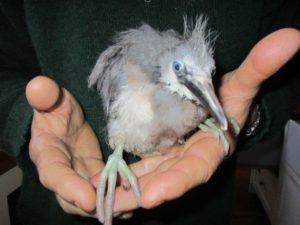
Little Feathers: “Whoa . . . what the hell just happened?”
The chain of events that saved the life of the baby white-faced heron began months before the stormy night it fell from the nest. The eternal rain also played a part, for if this winter had been as mild as last, the bulls wouldn’t have busted through a weak spot in the fence to scoff rank kikuyu.
Our fence fix was such a limp effort I moved the horse elsewhere when the bulls returned to the troublesome paddock and this turned out to be a wise move. Five bulls invaded the paddock and it was mid morning before the farmer returned them to their mates which by then had moved to fresh pasture.
He came home from this mission carrying a sodden, bedraggled and ominously still baby heron he’d found under the macrocarpa where the birds nest. Later he said it had looked so near death that he’d considered chopping off its head to put it out of its misery.
Soon the chick was in front of the blow heater while I turned it regularly to ensured it dried out and didn’t get toasted. A Whangarei Native Bird Recovery Centre volunteer advised that a hot water bottle be brought into service.
As the little bird dried out, life flowed back in and the bird perked up so much it squawked when it felt threatened, but soon gave up this aggressive attitude.
Recovery Centre staff had advised us against feeding it, but it did seem pleased to get a speck of smoked mullet down its gullet. Its body was the size of a large pine cone.
That evening Little Feathers, named by a friend, joined our three cats in front of the fire, kept safe by a mesh cage over its box. Residual heat keeps the room warm, but in the early hours I refilled the hottie. Little Features slept curled in a tight ball.
The next morning it was awake and alert, watching as I prepared to set off for the Recovery Centre. It spent the journey curled up in her – or his – box. Little Feathers waited in my warm car during my morning appointment and, by the time I returned, was sitting up and swivelling her head to check out the surroundings. I was enchanted. The feathers on her neck lay in a spiral pattern as if she could turn her head full circle.
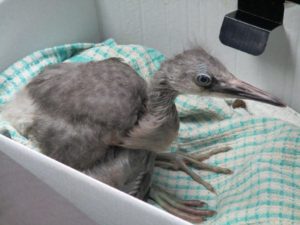
Little Feathers perked up in my warm car.
A Recovery Centre volunteer gave us a warm welcome, took Little Feathers into her arms and muttered about the foolishness of white-faced herons. “They make ridiculous nests,” she said. “A few sticks crossed over each other high in a tree.” I imagined a set up for noughts and crosses.
She assured me that when the time came to release the bird, it would return to its home at Batley and I can hardly wait.
As I farewelled Little Feathers knowing she would get better care than the farmer and I could give her, I felt a rush of emotion. Saving that bird’s life had been extraordinarily rewarding.
Little Feathers will enjoy a bonus in life simply because it fell from the nest. The little grey bird won’t be forced to take its maiden flight from an uppermost branch of a tall macrocarpa.
Having watched baby herons teeter for ages as they pluck up courage to fly while their mother screams instructions from nearby, I reckon it might almost have been worth taking the fall on that dark and stormy night.
]]>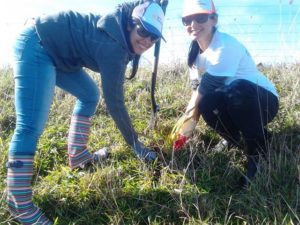
Spark staff, from left, Rachita Dahama and Gurpreet Jaura planting the coastline at Batley on the Kaipara Harbour.
People power to plant the edge of the largest harbour in the southern hemisphere is being provided gratis by one of our country’s largest companies.
Spark NZ, through its charitable arm the Spark Foundation, enables its staff to spend a day a year contributing to a worthy cause. Last week, 11 Spark people turned their attention to waterfront land at our place where hundreds of native saplings sat ready to be planted.
Mark Vincent, the initiator of Otamatea HarbourCare, which has a goal of planting many kilometres of harbour waterways, had grown them in his nursery with the help of volunteers. The week before Mark had attended another planting day, this one with children from diverse backgrounds. Although they were horticulture students, they turned up in school uniforms. No gumboots in sight.
We were luckier, despite many of our guests having begun life in other countries – or their parents had. Most were quietly spoken, making communication a test; when a young man waved a paper cup and said ‘Rubbish bin’, I thought he said ‘Aspirin’ and offered him a Panadol. We worked it out.
We also struck luck with the weather. Friday dawned still, clear and beautiful. Our guests arrived when the tide was in and began taking photos of our calm and glittering Kaipara Harbour.
While eating pikelets and muffins (cooked by the farmer’s mother), we introduced them to the place – they were beside the Otamatea River, the central arm of the harbour and in a house that began life in 1866. And that’s one reason Mark chose Batley for the first Spark Foundation day – we’re on the waterfront and the house and area abound with wondrous stories. The first settlers, for example, had seven daughters but only one reached adulthood. Twins were still born, three girls drowned and another died of pneumonia and is buried on the hill behind our house.
After planting, we served lunch to our rather exhausted guests. Practice has taught us that soup is the answer when feeding a large or unknown number of people. It can be eaten standing up if necessary and can cater for all diets. We served pea and ham, seafood chowder and Thai pumpkin.
While we were from different worlds, we women bonded over the pumpkin soup. It’s simple and delicious. First, split your pumpkin. This doesn’t need a knife or the slightest effort. Drop your pumpkin, with force, on a hard surface like your concrete drive or path. It will break in two, easing the business of cutting it into pieces.
Already another batch of pea and ham soup is in the freezer and I’m primed to crack another pumpkin on our concrete courtyard. Our second group of Spark volunteers is due soon.
Margaret’s Thai Pumpkin Soup
(I name recipes after those who give them to me – our visitors took away a recipe for Rae’s Thai Pumpkin Soup.)
1.5 kg pumpkin (I bake the pieces, cool then peel them).
2 onions, chopped
3 stalks celery, chopped
4 cups chicken stock (use vegetable stock to cater for vegetarians)
1 Tb red curry paste (Gregg’s is good and the only one I use)
Simmer the lot, whizz till creamy then add a can of coconut cream. It is especially lovely with coriander sprinkled atop its surface.
]]>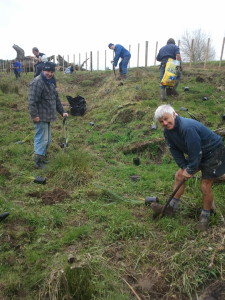
Otamatea HarbourCare members – the farmer front left – getting stuck in planting natives to improve water quality in the Kaipara Harbour.
Each morning I’m a picture of sartorial style in muddy overalls, beanie and gumboots as the farmer and I move cattle. Up until the big wet we moved young bulls in the intensive grazing system every two days, but now they’re in smaller paddocks. In larger areas they stomp the lot to muck by the end of day one and stage a mutinous break-out in day two.
As it was, there were break outs because the electric fence system took a hammering in the storm. But that’s a tiny glitch compared to what many farmers are facing, plus I’ve found returning Houdini cattle to their paddocks to be surprisingly satisfying.
My dog Floss and I sometimes walk several hundred metres to bring back escapees. One lot spotted me as I approached and came running at a gallop, like naughty schoolboys who’d been caught out. There’s always one laggard and as we plodded to get him, I expressed this to Floss in strong farmer language. The big wet does tend to inspire a colourful vocabulary, even among lucky ones like us.
The farmer calculated that at flood’s peak, only about one percent of the farm was under water. Some farmers have 90 percent of their land swamped. That morning Floss and I did face a sludgy battle of wills, but the bulls eventually galloped into a valley and up the other side and were soon with their mates. I was thrilled.
Then, last Saturday, cattle moving done, the farmer and I picked up spades and headed off to plant native trees. I also find it surprising satisfying to head off the farm clad in muddy overalls and gumboots and not give, as my dog Floss would say, a dog’s biscuit what I look like.
It was my second planting of the week and the farmer’s third. With the manager and helpers, he’d planted about 1200 natives on the edge of the farm, then he and I dug up flaxes that had taken root in his mother’s garden. After separating the big ones, we planted about 70 between the coastal fence and harbour.
“They don’t go far,” observed the farmer after we were done.
On Saturday we attended the inaugural planting day of the fledgling Otamatea HarbourCare group which has the slogan, ‘Productive land with a healthy harbour’.The team put in about 750 flaxes, cabbage trees and manuka by a waterway on a farm that borders State Highway 12. It will be a living advertisement for the group and the massive and long-term effort required to plant the edge of the Kaipara Harbour to reduce run-off and increase water quality.
Afterwards we gathered in a farm shed. As lunch came to an end, it was time for a speech acknowledging the momentous occasion. Mark Vincent, who’s taken on the task of getting the group going, drew inspiration from Winston Churchill: “Now this is not the end. It is not even the beginning of the end. But it is, perhaps, the end of the beginning.”
If spending a weekend morning in mud and gumboots (overalls optional) and leaving a legacy of coastal plants appeals, you can find out about future planting days by emailing mark.cindy.vincent @ gmail.com (remove the spaces which are there to prevent spam).
]]>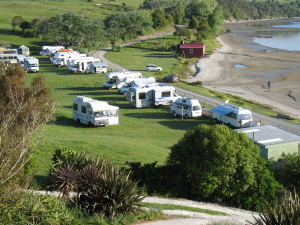
Campervans in a paddock where it’s legal to park because thei owners have kindly asked.
I hadn’t thought ‘lightly’ and ‘politely’ could be interchangeable until a letter from a rental vehicle company proved that, indeed, this is so.
We share a Kaipara beach with ‘no camping’ signs which were ignored by some freedom campers I met during a preprandial wander. The couple, whose van had been parked all day, were relaxing on deck chairs on the beach. The man acknowledged me, but the stiff set of the couple’s backs indicated they had no wish to chat.
I walked past their van, past a fire on the beach and . . . .urghhh!!! . . . past dirty pieces of tissue paper near the boat ramp. Yick!!!
As if by karma, a clean plastic bag lay at my feet. I used it to gather the toilet paper then approached the stiff-backed couple who told me they were from Europe and that this was their third New Zealand holiday.
I politely mentioned the no camping rule and offered a camping spot in a nearby paddock. The declined and looked surprised when I said the beach was popular with boaties and families and that there was a nearby toilet.
“Some naughty people used the grass as a toilet,” I said, indicating the ‘treasures’ in the plastic bag.
They left the next day leaving wood on a fire that smouldered near dry kikuyu.
What would you do? I wrote to the vehicle hire company and days later received a prickly reply informing me I’d made incorrect assumptions. The writer also asked why I hadn’t lightly pointed out that camping wasn’t permitted.
Confused, I checked my letter and found I’d made no assumptions, incorrect or otherwise – I hadn’t accused the company of not educating campers, but said I’d been unable to find this info on their website. And in the circumstances, was the tone of our interaction relevant? Now I felt prickly.
I replied saying that, in fact, they had made an incorrect assumption as I had spoken “lightly” to the campers when I offered them a legal camp site.
A few days later, glancing at the grouchy letter, I realised I’d misread it. I don’t mean to make fun of the writer’s spelling ability – we all have different strengths and weaknesses – but I’d been asked to speak “per lightly” to the campers, i.e. “politely”.
In my chummy reply, I’d agreed with the writer’s idea that, if a similar thing happened again, I should contact the relevant car hire company. I didn’t mention that he’d incorrectly assumed I was a bloke.
]]>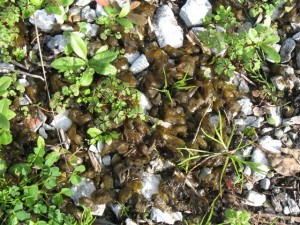
This brown scum that thrives in our wet winters is called Nostoc Commune
Anticipating cultured conversation after a local theatre performance, we retired to the bar for a night cap. But as this is a rural area, talk was all about an entirely different type of culture – a strange gooey, gunky and shiny brown growth.
I’d first spotted it while being a marshal for the Rally of New Zealand. After poking it with the toe of my boot, I decided it resembled seaweed or pond scum – except it was flourishing in roadside gravel. A while later, there it was again – gleaming (in a rare spot of sunshine) on our drive.
That night after the play, I was in the company of many seasoned farmers – who had all spotted its recent arrival, but knew nothing about it.
“I’ll do the research,” I said, “and let you know.”
Northland Regional Council’s biodiversity specialist double-checked with NIWA’s algal experts who confirmed it’s Nostoc commune, commonly called Blue Green Algae.
A mind-dizzying visit to Wikipedia and thereabouts taught me it’s a type of cyanobacterium (blue bacteria) which can live in salt and fresh water, soil and, as we know for a fact, bare rock.
As well as finding out spirulina belongs to the extended family and that there are countless types with long and scientific names, I also know this: “They are Gram positive prokaryotes. They are photosynthetic and have pigments like chlorophyll a, carotenoids, along with phycobilins. They have autotrophic mode of nutrition.” And on and on. Knew you’d be fascinated.
The Nostoc thriving in Kaipara may be the strain known as fallen star or star jelly. It can fix nitrogen, reclaim soil and is so hardy that, after lying dormant for ages, it grows again when exposed to water.
You can, apparently, kill it with various things: salt, vinegar, copper sulphate, dairy alkali cleaner XY12 (full strength or one part to two of water) or possibly glyphosate or algae killer.
As some strains of cyanobacteria are highly toxic, I’d recommend you do more research before you use Nostoc as a food supplement which is what they do in China.
Several people have since told me they reckon it grows where glyphosate (better known by the brand name Roundup) has been sprayed. More research is underway. Stay tuned.
]]>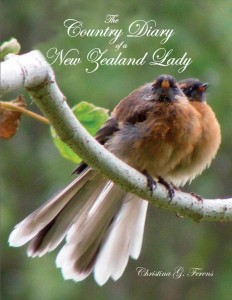 As a writer about rural life, I was recently asked to review a book by another Northland writer, Christina Ferens. The Country Diary of a New Zealand Lady is glorious; it’s both a meditation and a celebration of the birds, animals, and plants which many of us see every day and don’t give a second thought.
As a writer about rural life, I was recently asked to review a book by another Northland writer, Christina Ferens. The Country Diary of a New Zealand Lady is glorious; it’s both a meditation and a celebration of the birds, animals, and plants which many of us see every day and don’t give a second thought.
Her writing is excellent and inventive – she expresses her observations with clever originality. Her writing is also gentle, insightful, loving and reminiscent of a past era when people lived at a slower pace than most of us do today.
After the book launch at the Takapuna Library, Christina emailed to say she was pleased with my review (of course she was, it’s a fabulous book) and that she’d even referred to it during the launch. I asked Christina if she’d share some background about her book and life and she agreed.
Hi Christina – thanks for agreeing to be part of my blog.
My first burning question is this: your book includes many fabulous photos. What sort of camera do you use? Is it so tiny you can carry it with you almost constantly or do you set off on photographic missions, set yourself up and wait for the magic moment – or is it somewhere in between?
Not a pocket camera, but with the view-finder essential for bird photography and an extraordinary zoom capacity, the Fuji Finepix is light enough to be almost constantly round my neck. To capture those spontaneous moments, I soon learned to have it switched on and zoomed up before even setting foot outdoors and to leave it on till I was literally back inside, regardless of the drain on the battery. That way I caught the lovely pair of greenfinches so close when I was on my way indoors, finished for the afternoon as I thought.
Your writing is poetic and engaging. Do you scribble your thoughts in a notebook or do the words come to you when you sit at your computer? Or do you take a laptop into a paddock?
Thank you for the compliment. Nothing so organised as a notebook or even laptop!
I like to mull the words around in my mind when they come to me and to have pen and paper on hand wherever I am. By the end of the year I had a whole hand-written manuscript.
Is there a particular time of day when you write?
For the purposes of the diary, I would already be gathering up my thoughts by mid-morning and by late afternoon I was usually ready to wrap up my entry for the day. If I write a poem, I can be sure to see it during the ‘night watch’, the lines written clearly against the darkness so that I can make improvements which elude me in light of day.
I am quite used to writing in the dark!
What led to the publication of the book? Had you written a diary for some time and realised your scribing could grow into a book – or what? Was it your idea or someone else’s?
Certainly my own idea and one which had been germinating since I came across an old copy of “The Country Diary of an Edwardian Lady”. I imagined doing something beautiful like this for New Zealand and shortly afterwards, very late in the year, happened to move house to the perfect setting. On New Year’s Day I got out pen and paper.
A daily diary is a huge commitment. How did you manage to keep it up?
The enormity of what I had undertaken (the relentlessness, even, of the constant observations) came home to me one afternoon in March. By next morning I was as determined as ever and come the frostiest morning I was outdoors first thing in dressing-gown, gumboots and parka! I was having a love affair with words as well as with my subject, and I was spurred on by the knowledge that I was creating a unique record. Then, I had the advantage of hemisphere; with spring falling two-thirds through the year, followed by summer nesting, my involvement continued to grow and I was provided with a natural climax to the book.
Did you happen to count the number of species in the natural bird sanctuary around you?
There are 48 species of bird detailed in the appendix, and some gained the limelight more than others. I gave myself a rule that any mention at all was to shed an additional light or describe a new aspect of behaviour. By the end of the book, the reader should have built up a comprehensive knowledge of the birdlife.
What makes this book different from any other ‘bird book’ I’ve read is the fact that the birds seem to take on their own personalities. Can you comment on this?
There is certainly an intimate perspective to this natural history. A fascination for me, in observing the same bird families over the period of a year, is that different idiosyncracies did emerge, highlighting loyalty and personality beyond our own. The swallow couple, who nested opposite our front door, is a case in point.
Do you have an entry in your diary – and book – which is a particular favourite and which perhaps evokes fond memories?
Probably the last one, when I seemed led to the right spot at the right time throughout a day of memorable happenings that enabled me to draw in many of my main ‘characters’ and so ‘tie up all the ends’ in a satisfying way.
You must have been delighted to have your book as one of the best animal books of the year in the NZ Herald Canvas magazine. Has it been reviewed elsewhere?
The first review (copied below) ran in ‘”Bay Chronicle'”and ‘”Northern News'” and your own review for ‘”The Northern Advocate'” also ran in seven other provincial newspapers from ‘”Northern Age” to ‘”Oamaru Mail”.
Your book is published by Faith House Publications. Can you tell us a little more about them?
Being a books editor, I have set up my own publishing house by this name to produce my books, wall calendars and floral cards.
Is there a website where people can buy the book?
www.whitcoulls.co.nz If Whitcoulls are out of stock, purchase thru: [email protected]
What other writing have you done or had published?
“Where the Wind Wills” is a smaller book in which I first took natural history as a subject for literature. This time it is a whale at the ‘front door’, in the first of a series of seven unique and stunning environments from Island to Deep Country, from Ocean Beach to The Farm. This book includes my own pencil sketches rather than photographs, and also the original poetry. My first published poem appeared in “New Zealand Bookworld” many years ago.
If you had a word of advice for a writer, what would it be?
My advice is to visualise clearly the concept of the book and even, if designing it yourself, create the whole book in your mind’s eye from the outset, and then to write a list of goals and guidelines that will bring it into being.
Can you tell us a little about your farm – its size, how long it’s been in your family, etc?
Actually we rented the one dwelling on a farm being used as a run-off and bounding a vast sheep-and-cattle station. The farm is about 175 hectares and the beauty of it (apart from its very special plantings, such as a gingko tree by an unfrequented stream-crossing) is the extent of the wetlands that attract the birds. I never lost my sense of wonder at it all, being city-bred, and I think the success of the book derives from this wonder. I am told the book has opened the eyes even of those who have lived in the country all their lives.
And lastly, you live in rural Northland, but I have an idea your place is more remote than ours. We’re about 20 minutes’ drive from the nearest town – how far away are you?
We are still only 20 minutes’ drive from the nearest town.
Thanks for taking the time to share, Rae.
I’m grateful, Rae, for the opportunity to look back on the steps I took to achieve my goal. The journey was the best part.
PS: And here’s my The Northern Advocate review.
Christina Ferens lives on farm in the Far North where she notices the nuances of nature and writes about them – every day.
She also takes photographs, sometimes going to great trouble to capture that magic moment in time when, say, a turkey chick sits on its mother’s back or a drinking yearling is reflected in a pond.
The result of her labours with pen and camera is a glorious book that’s both a meditation and a celebration of the birds, animals, and plants which many of us see every day and don’t give a second thought.
Her writing is excellent and inventive – she expresses her observations with clever originality. Her writing is also gentle, insightful, loving and reminiscent of a past era when people lived at a slower pace than most of us do today.
Christina has an encyclopaedic knowledge of New Zealand birds; her skills even include determining whether a female or male blackbird “gave voice”.
Written as a journal, with one chapter per month, the book is peppered with photographs, mostly of birds but also of livestock and the countryside she clearly loves. She describes it as the Taheke hinterland.
This is not a book to be read in a rush, in fact, it would be my preference to keep it on my desk or at my bedside and read her observations as a daily ritual.
It commences on New Year’s Day (these are her notes from 2008) and the first entry details the antics of a fantail, a shining cuckoo, and a pair of nesting swallows whose fledglings need no longer “fling themselves with parted beak half over the edge of the nest in a limp effort to keep cool, for the man-of-the-house has kindly placed a piece of wood on the clear roofing above to protect them from the unrelenting summer sun.”
That excerpt – paragraph three in this 250-page, large format book – gives a sense of the pace and tone of what is essentially a diary. Entries rarely exceed 150 words; some are shorter. The typeface and layout make for an effortless read.
It would make a gorgeous gift. Yes, I know, suggesting any book would make a gift can seem to be damning it with faint praise, but that is not my intention.
As I have written this, with the book open beside me, I have felt my blood pressure settling, my mind calming and my mood lightening.
The book is a treasure that would be loved by anyone, but I imagine it might bring special joy to anyone who is say, in a rest home, in hospital, incapacitated, or who is locked in a corporate life – leaving home and arriving home in the dark with the intervening hours spent in a multi-storey building whether in Auckland or Hong Kong.
Anyone who lives on farm will identify, as will those folk who have left the family farm and now reside in an urban area.
The blurb likens the book to The Country Diary of an Edwardian Lady, written by Edith Holden in the early 1900s, published in 1977 and a best-seller. The Country Diary of a New Zealand Lady deserves that same good fortune.
Rae Roadley
Feast for bird and garden lovers
For most of us, busy with other things, seasonal differences are what we notice in the nightly weather forecast, but with this book author Christina Ferens invites us in to observe a feast of change that happens while our attention is elsewhere.
A day-by-day record of life in and around farm hedgerows and gardens takes us through the seasons of mating, breeding, rearing and feeding that busies the lives of birds and insects; all of it observed in fascinating close-ups and illustrated in a profusion of full colour photographs.
It’s also a sharp reminder that life at this level is lived in a jungle. Wasps and birds predate on insects, birds predate on each other, feral cats and possums predate on most things while overhead the big raptors cruise, looking for anything they can lift off the ground.
Christina identifies particular nests at risk and records the small wins as mothers fight fiercely to protect their young or the sad posses when they fail to prevent their eggs or chicks being snatched.
The entry for the first day of January is almost lyrical. “A fantail flew closely above my head as I stood in the shadow of the banksia, at the entrance to the lawn, and a shining cuckoo whistled sevenfold welcome to a new year just hours old. All day the welcome swallows flit about the rafters of the pergola where one pair tends a nest atop a wooden support; excited cheeping comes from two nestlings whenever a parent bird flits by. Sometimes they flutter in one spot, hummingbird style, taking insects from little spiders’ webs.”
Every day of the year is described with the same attention to detail, with birds identified in an appendix and their status, whether protected, native, endemic or introduced.
Christina Ferens lives in the Taheke hinterland, in Northland. Her love for the area and its natural beauty shines through on every page.
Bob Molloy Bay Chronicle; Northern News
“The charm of the language lends it to being read aloud … The other thing I really loved … is that you can get the picture of the stillness of the days and the intense heat of a Northland summer … there is just this quietness of nature … and I think it is a clever writer who can depict that.”
— Helen Woodhouse, Takapuna Library Manager, speaking at the book launch
]]>About a year ago we bought eight new deck chairs which, as three hapless guests have taught us, have a design fault.
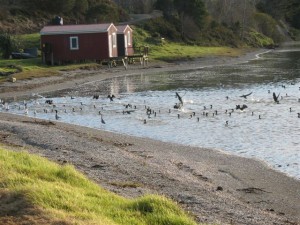
Happy shags in a feeding frenzy
So far three chairs have cracked in the same place taking three different guests with them. The farmer and I use the chairs daily but none has broken under us. In the interests of our guests, we have had some chairs replaced and are working to resolve the problem.
It was great to have a guest for company when, just minutes after the farmer had gone out, a possum wandered into the dining room.
The startled creature fled upstairs with me in pursuit, but I was too slow to see whether it had left via the terrace or was hiding in a bedroom.
It was, therefore, handy to get a report from the guest when I returned to the dining room. In my absence she’d heard a squeal and opened the back door – a cat streaked inside.
She figured it had been the cat that yowled, but as the back deck was coated in possum fur, we concluded otherwise, reasoning the possum had jumped from the terrace to the ground where it had been set upon by Kate the dog.
The guest, who also turned out to be a handy source of information, said possums can shed fur so they can escape attackers; we never did find a dead possum.
The longer you stay the more likely you are to experience more than one mishap, so this same guest also scored a cold shower.
When one gas bottle runs out, the supply is supposed to flow from the other bottle but, for a reason that’s beyond the farmer and me, this doesn’t happen.
It was jolly unfortunate that the gas ran out when the guest was showering at 11pm. It was also jolly decent of her to insist that I didn’t emerge from my cosy bed to turn on the full gas bottle.
It was also handy to have friends staying when a fisherman snagged a shag in his net. Rather than ask his family, which was nearby, to help, he slashed the net with a knife until the shag was cut free – but it was still entangled in a piece of net.
We watched the action with binoculars – and growing alarm – as the bird struggled to a small sand spit to ponder its fate. Without intervention, this would have been an early death.
A friend and I set off with a towel, scissors and the sort of environmental righteousness which excels in company. The bird tried to swim away, but had no show. I waded out and grabbed it in the towel.
We were settling down to snip it free when it stretched its elastic neck and pecked a chunk out of my forehead.
I was amazed! What was the bird thinking, attacking me when there was a perfectly good guest available?
]]>
